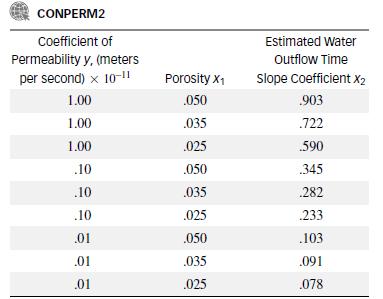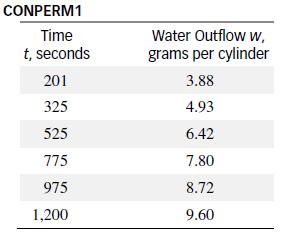Refer to Exercise 11.66. Vuorinen fit the water outflowtime model for each of nine permeabilityporosity combinations and
Question:
Refer to Exercise 11.66. Vuorinen fit the water outflow–time model for each of nine permeability–porosity combinations and used the results to develop a model for the coefficient of permeability of concrete, y. Specifically, he fit the model*
E(y) = βo + β1x + β2x2
where
x1 = Porosity of the cement
x2 = Estimated slope coefficient (α̂1) of the corresponding water outflow–time regression line
The data are reproduced in the next table.

a. Find the least-squares prediction equation and interpret the β estimates.
b. Conduct a test of overall model utility. Interpret the p-value of the test.
c. Is there evidence that concrete porosity x1 is a useful predictor of coefficient of permeability y? Test using α = .05.
d. Is there evidence that the estimated water outflow–time slope is a useful predictor of coefficient of permeability y? Test using α = .05.
e. Find R2 and interpret its value.
f. Find the estimate of s and interpret its value.
g. Find a 95% prediction interval for y when x1 = .05 and x2 = .30. Interpret the result.
Data from Exercise 11.66
J. Vuorinen carried out a series of experiments to gather information on the coefficient of permeability of concrete (Magazine of Concrete Research, Sept. 1985). In one experiment, the outflow of water from the pores of a concrete specimen after it had been under saturating water pressure for a period of time was recorded for different combinations of concrete permeability and porosity. The resulting water quantities after different lapses of time for one permeability–porosity combination are given in the table.

Step by Step Answer:

Statistics For Engineering And The Sciences
ISBN: 9781498728850
6th Edition
Authors: William M. Mendenhall, Terry L. Sincich





